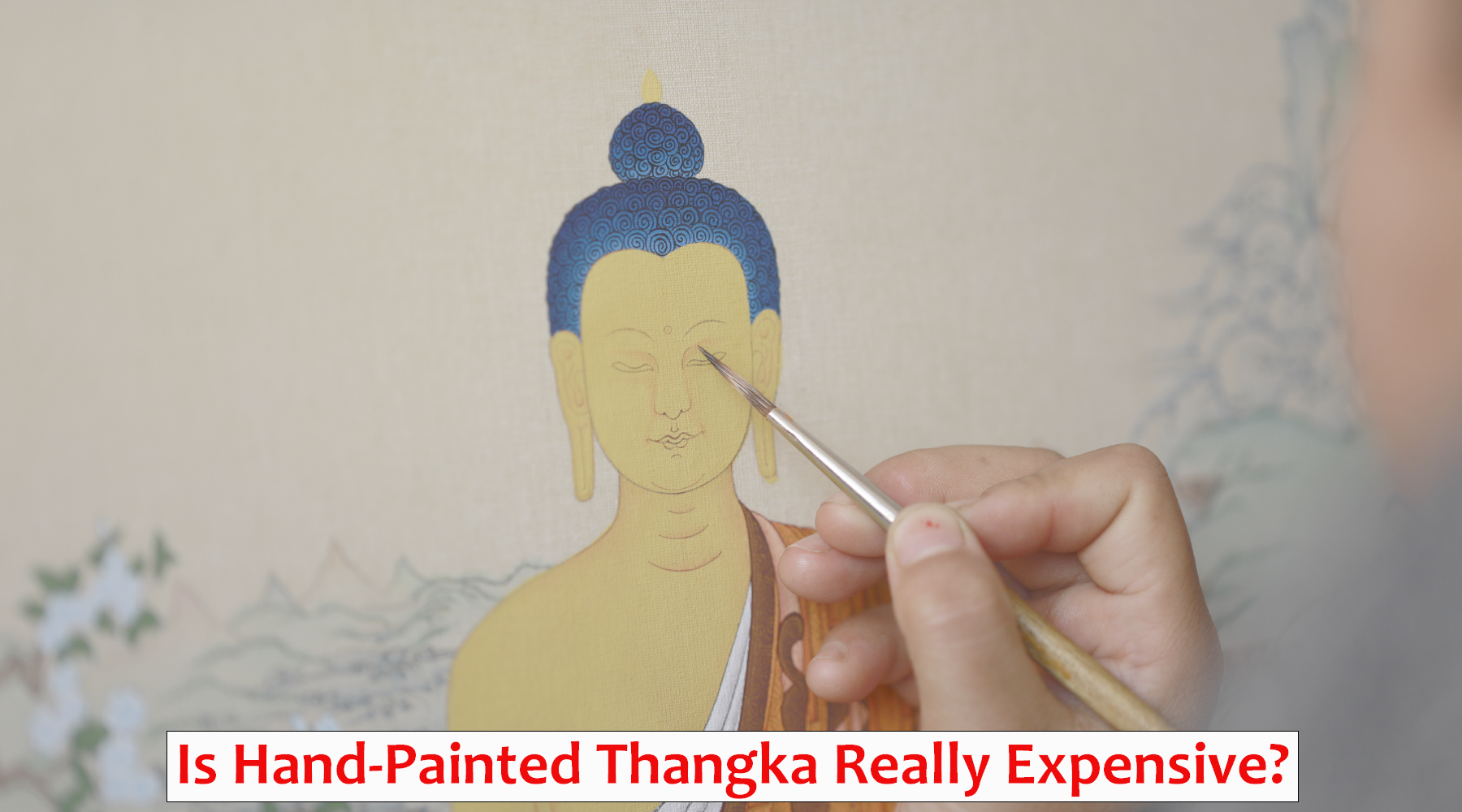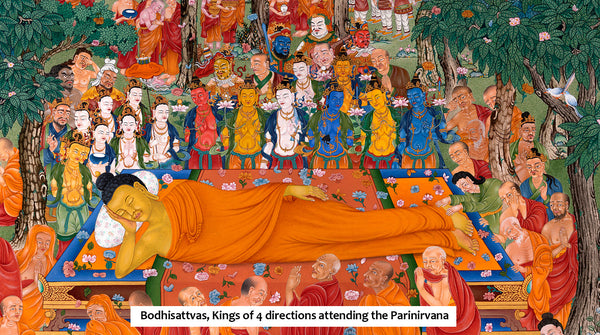The Making of Thangka: Its Significance & The Value
Thangka is highly esteemed and holds special significance in Buddhist culture. It is generally employed to enlighten practitioners about the Buddha's life, times, customs, and other bodhisattvas. Thangkas are painted with the sole goal of assisting you in your meditation practice that features representations of deities in various forms, fulfilling multiple purposes and holding numerous objects.
There are several applications for Thangka. Not just by the core devotees but also by others for positive vibration, prayer, meditation, and spiritual practice. The Thangka swiftly transforms into a meditational tool for anyone who wants to contemplate Buddha's life and existence since it depicts Buddha's physical manifestations and distinctive characteristics.
If you enjoy performing rituals and prayers, then Thangka would be a tremendous help. You can offer prayers, conduct rituals, and repeat mantras loudly about the respective deity shown on the Thangka. It can also be applied to cultural adaptation.
Stretched Cotton Canvas: The base of thangka
Making a cotton canvas for the Thangka painting is the foundation of any Thangka painting. People also often use other woven materials, such as linen and silk. The preparation of cotton canvas is a tedious task. Beginning with the cotton of the required measurement, it needs to be stitched on all four sides to a wooden or metal frame. The cloth must be sewn tightly on the frame. Then a mixture of water, white clay, and glue are prepared, neither too runny nor too thick. This must be applied on both surfaces and then left to dry.
After one of the sides has entirely dried, it is moistened by being repeatedly and gently rubbed with a smooth stone or a cloth. The canvas is left to cure once the entire surface is done. On the other side, the same process is then repeated. The process is repeated until the desired smoothness is obtained. Thangka's surface must be smooth to paint. This whole process takes from a couple of days to a week.
Pencil Sketching: Drawing the first draft
Following a complex grid system, thangka artists must draw each figure according to precise measurements and proportions as mentioned on Buddhist scriptures. The deity portrayed in the Thangka must be accurate to the traditional iconography. One cannot imagine the deity themselves. There must be precision in every stroke of the brush. The artist outlines the respective deity with a pencil.
Creating the Color Pallet
Click here to view our High Quality Thangka Paintings
Traditionally, the paint used for Thangka consists of pigments of water-soluble medium and glue. However, both mineral and organic pigments are still used today. For the Thangka, traditionally natural stone colors are used. These stone colors are extracted in their natural form, grounded and then turned into applicable paints. Different artists use acrylic paintings, flowers, and wood dust. Fine brushes are used to paint the picture.
Mandalas and Deity figures must be drawn in exact conformity with guidelines outlined in Buddhist literature. To make accurate and authentic Thangka, the artist must have the appropriate training and possess enough religious understanding, knowledge, and background after the drawing and coloring is the next stage.
The thangka artist creates a pure intention free of self-serving motivations and begins the painting process with a joyous mind for the final Thangka to deserve the practitioner's steadfast devotion, offering, and meditation practice.
Each of us responds differently to various shades. However, many deities are represented in multiple color palettes; thus, one's intent may drive the color choice. The right color scheme combination is essential during the painting process. The reflection of color has a unique effect on the human brain. This is crucial for both the artist as well the customer.
Preparation of the Gold: Secret Technique of Newars
One of the specialties of Thangka made in Nepal is using genuine 24K gold. The use of gold in the paintings is only found here in Nepal. Furthermore, there are only a few numbers of newar families from Kathmandu valley who have mastered the technique of converting the solid gold into applicable paint.
A substantial amount of gold is used to highlight and give exquisite touches. This is a challenging, intricate technique. It takes 7 to 10 days to prepare the gold and another 6 to 25 days to apply it. The gold must first be heated, cleaned, and beaten.
The artist crushes the gold sheets into tiny bits and mixes them with water, glass or marble grains, and other ingredients in a mortar. He grinds the mixture until the marble or glass pieces are little more than dust. The mixture is added with more water, covered, and a night to settle. By morning, the gold settles at the bottom, leaving the milky mixture of marble water that is dumped off.
The surface water is drained off every morning for seven days as this procedure is repeated with glue addition. The gold is mixed with glue before being thoroughly crushed to remove any impurities. The gold must be ground continuously so that it becomes a powder. Then mixed glue and artistically applied it to Thangka paintings.
Framing of Thangka
Finally, after the completion of the Thangka, it is framed. Traditionally Brocade is used to frame thangkas. These brocades are the high quality silk, hand woven in most of the cases. The best know quality of these silk are from Veranasi.
However, there are alternative possibilities for Thangka, including glass framing and custom wood frame with or without glazing protection.
What Determines The Thangka's Price?
The price of Thangka varies from one another. It is not the size of Thangka that alters the pricing but the amount of detail presented in the painting. The process of hand-painting Thangka takes from couple of months to more than a year to complete, working about 7 hours daily. If the intricacies in the artwork are skillfully painted, the price of a smaller thangka might often be more than that of a large one. There are thangkas of every quality, from very low to top-notch.
Higher quality products are pricier. Intricate detail such as facial characteristics and deity clothing patterns, the elegance of style-traditionally exact proportions and geometric ratios, subtle shading, the use of traditional colors and pure gold rather than gold paint, and an master artist are some indicators of excellent quality art. The final Thangka is made especially sacred with the blessing of the energy generated by the enlightened lama.
The Thangka is valued as a living manifestation of enlightened energy rather than just another product. It is a specialized form of art that takes years of practice and patience. The actual painting is magnificent, bright, and filled with minute details that frequently reflect themes of Buddhism and the life of Buddha.
Especially in some of the most intricate mandala designs, which are designed to capture the entirety of the world in a single frame, this produces paintings with an utmost mathematical degree of precision and symmetry.
An artist may work on a painting for months or even years before it is finished, depending on its size and complexity. The amount of hard work, dedication, concentration and devotion that goes into Thangka paintings are beyond any explanation.


